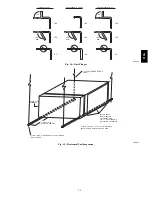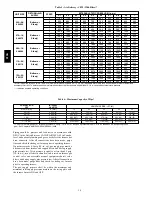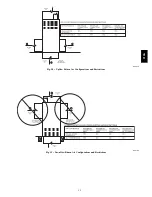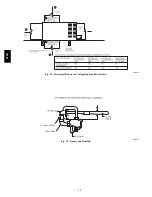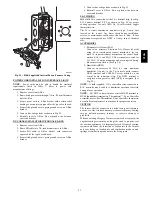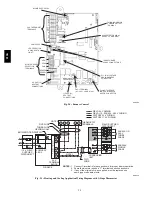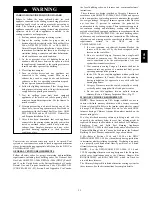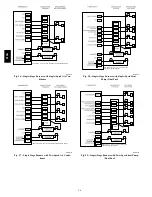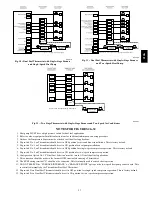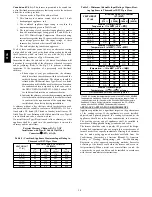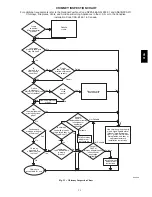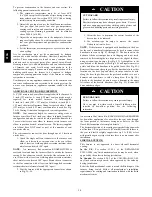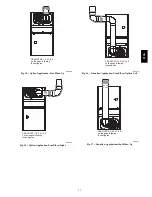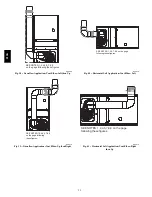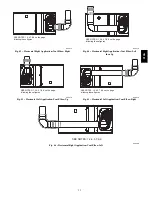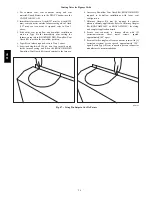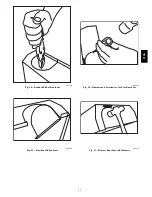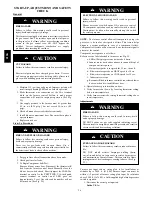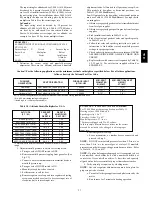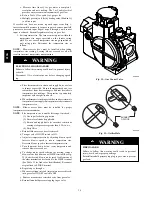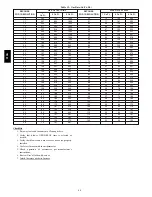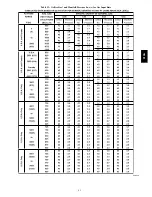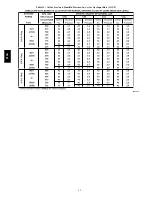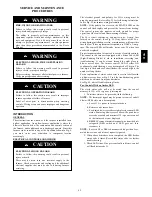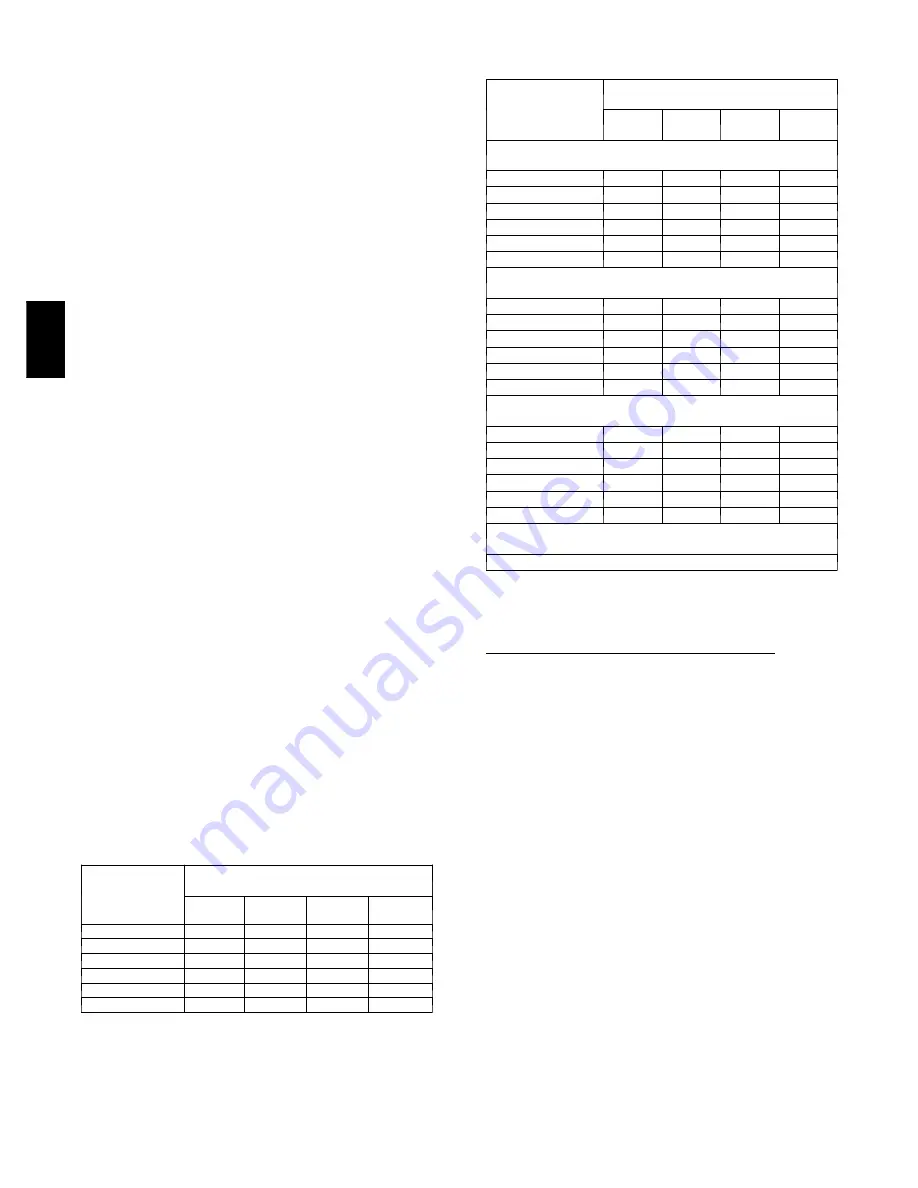
28
Canada (and U.S.A.
)--This furnace is permitted to be vented into
a clay tile--lined masonry chimney that is exposed to the outdoors
below the roof line, provided:
1. Vent connector is Type--B double--wall, and
2. This furnace is common vented with at least 1 draft
hoodequipped appliance, and
3. The combined appliance input rating is less than the
maximum capacity given in Table A, and
4. The input rating of each space heating appliance is greater
than the minimum input rating given in Table B for the
local 99% Winter Design Temperature. Chimneys having
internal areas greater than 38 square inches require furnace
input ratings greater than the input ratings of these
furnaces. See footnote at bottom of Table B, and
5. The authority having jurisdiction approves.
If all of these conditions cannot be met, an alternative venting
design shall be used, such as the listed chimney adapter kit with
these furnaces, which are listed for use with the kit, a listed
chimney--lining system, or a Type--B common vent.
Inspections before the sale and at the time of installation will
determine the acceptability of the chimney or the need for repair
and/or (re)lining. Refer to the Fig. 33 to perform a chimney
inspection. If the inspection of a previously used tile--lined
chimney:
a. Shows signs of vent gas condensation, the chimney
should be relined in accordance with local codes and the
authority having jurisdiction. The chimney should be
relined with a listed metal liner, Type--B vent, or a listed
chimney adapter kit shall be used to reduce condensation.
If a condensate drain is required by local code, refer to
the NFGC NFPA54/ANSI Z223.1--2006, Section 12.10
for additional information on condensate drains.
b. Indicates the chimney exceeds the maximum permissible
size in the tables, the chimney should be rebuilt or relined
to conform to the requirements of the equipment being
installed and the authority having jurisdiction.
A chimney without a clay tile liner, which is otherwise in good
condition, shall be rebuilt to conform to ANSI/NFPA 211 or be
lined with a UL listed (ULC listed in Canada) metal liner or UL
listed Type--B vent. Relining with a listed metal liner or Type--B
vent is considered to be a vent--in--a--chase.
If a metal liner or Type--B vent is used to line a chimney, no other
appliance shall be vented into the annular space between the
chimney and the metal liner.
Exterior Masonry Chimney FAN + NAT
Installations with Type--B Double Wall Vent
Connectors
©
NFPA & AGA
Table 8 – Combined Appliance Maximum Input Rating in
Thousands of BTUH per Hour
VENT HEIGHT
FT. (M)
INTERNAL AREA OF CHIMNEY
IN
2
(MM
2
)
12
(7741)
19
(12258)
28
(18064)
38
(24516)
6 (1.8)
74
119
178
257
8 (2.4)
80
130
193
279
10 (3.0)
84
138
207
299
15 (4.5)
NR
152
233
334
20 (6.0)
NR
NR
250
368
30 (9.1)
NR
NR
NR
404
Table 9 – Minimum Allowable Input Rating of Space--Heat-
ing Appliance in Thousands of BTUH per Hour
VENT HEIGHT
FT (M)
INTERNAL AREA OF CHIMNEY
IN
2
. (MM
2
)
12
(7741)
19
(12258)
28
(18064)
38
(24516)
Local 99% Winter Design
Temperature: 17 to 26
_
F (---8 to ---3
_
C)
6 (1.8)
0
55
99
141
8 (2.4)
52
74
111
154
10 (3.0)
NR
90
125
169
15 (4.6)
NR
NR
167
212
20 (6.1)
NR
NR
212
258
30 (9.1)
NR
NR
NR
362
Local 99% Winter Design
Temperature: 5 to 16
_
F* (---15 to ---9
_
C)
6 (1.8)
NR
78
121
166
8 (2.4)
NR
94
135
182
10 (3.0)
NR
111
149
198
15 (4.6)
NR
NR
193
247
20 (6.1)
NR
NR
NR
293
30 (9.1)
NR
NR
NR
377
Local 99% Winter Design
Temperature: ---10 to 4
_
F* (---23 to ---16
_
C)
6 (1.8)
NR
NR
145
196
8 (2.4)
NR
NR
159
213
10 (3.0)
NR
NR
175
231
15 (4.6)
NR
NR
NR
283
20 (6.1)
NR
NR
NR
333
30 (9.1)
NR
NR
NR
NR
Local 99% Winter Design
Temperature: ---11
_
F (---24
_
C) or lower
Not recommended for any vent configuration.
*The 99.6% heating db temperatures found in the 1997 or 2001 ASHRAE
Fundamentals Handbook, Climatic Design Information chapter, Table 1A
(United States) and 2A (Canada) or the 2005 ASHRAE Fundamentals
handbook, Climatic Design Information chapter, and the CD---ROM in-
cluded with the 2005 ASHRAE Fundamentals Handbook.
APPLIANCE APPLICATION REQUIREMENTS
Appliance operation has a significant impact on the performance
of the venting system. If the appliances are sized, installed,
adjusted, and operated properly, the venting system and/or the
appliances should not suffer from condensation and corrosion.
The venting system and all appliances shall be installed in
accordance with applicable listings, standards, and codes.
The furnace should be sized to provide 100 percent of the design
heating load requirement plus any margin that occurs because of
furnace model size capacity increments. Heating load estimates
can be made using approved methods available from Air
Conditioning Contractors of America (Manual J); American
Society of Heating, Refrigerating, and Air--Conditioning
Engineers; or other approved engineering methods. Excessive
oversizing of the furnace could cause the furnace and/or vent to
fail prematurely. When a metal vent or metal liner is used, the
vent must be in good condition and be installed in accordance
with the vent manufacturer’s instructions.
313A
Summary of Contents for 313AAV
Page 41: ...41 Table 13 Orifice Size and Manifold Pressure In wc for Gas Input Rate A08220 313A...
Page 42: ...42 Table 13 Orifice Size and Manifold Pressure In wc for Gas Input Rate CONT A08220A 313A...
Page 44: ...44 Table 14 Orifice Size And Manifold Pressure In wc For Gas Input Rate A08221 313A...


